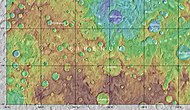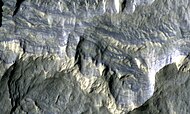Difference between revisions of "Columbus Crater"
(→See also: added to list) |
m (→Other minerals) |
||
| Line 9: | Line 9: | ||
<gallery class="center" widths="190px" heights="180px" > | <gallery class="center" widths="190px" heights="180px" > | ||
| − | Image:Columbus Crater Layers.JPG|Columbus Crater Layers, as seen by | + | Image:Columbus Crater Layers.JPG|Columbus Crater Layers, as seen by HiRISE. This false-color image is about 800 feet across. Some of the layers contain hydrated minerals. |
Image:Columbus Crater close-up.jpg|Close-up of Columbus Crater, as seen by HiRISE | Image:Columbus Crater close-up.jpg|Close-up of Columbus Crater, as seen by HiRISE | ||
</gallery> | </gallery> | ||
Revision as of 05:37, 18 August 2021
Columbus Crater is a 119 km wide crater Terra Sirenum, located at 29.8° south latitude and 166.1° west longitude, and was named after Christopher Columbus[1] Since sulfates and clay minerals have been discovered within Columbus Crater it is believed that a lake once existed in the crater. These minerals need water to form.[2][3] These were found using an orbiting near-infrared spectrometer. Spectrometers reveal the types of minerals present based on the wavelengths of light they absorb. These minerals would appear if a large lake had slowly evaporated.[4] [5] The discovery of some layers containing gypsum, a sulfate which forms in relatively fresh water, it is thought that life could have formed in the crater.[6]
Map showing the relative positions of Columbus Crater and other nearby craters in Memnonia quadrangle
Other minerals
In the layers, or strata, of Columbus Crater, the CRISM instrument on the Mars Reconnaissance Orbiter found kaolinite, hydrated sulfates including alunite and possibly Jarosite]].[7] Further study concluded that gypsum, polyhydrated and monohydrated Mg/Fe-sulfates were common and small deposits of montmorillonite, Fe/Mg-phyllosilicates, and crystalline ferric oxide or hydroxide were also found. Thermal emission spectra hint that some minerals were present in the tens of percent range.[8] [9]
See also
References
- ↑ https://planetarynames.wr.usgs.gov/Feature/1274
- ↑ http://www.nasa.gov/mission_pages/msl/multimedia/pia15099.html#.VWyD-c9VhBc
- ↑ Wray, J., R. Milliken, C. Dundas, G. Swayze, J. Andrews-Hanna, A. Baldridge, M. Chojnacki, J. Bishop, B. Ehlmann, S. Murchie, R. Clark, F. Seelos, L. Tornabene, and S. Squyres. 2011. Columbus crater and other possible groundwater-fed paleolakes of Terra Sirenum, Mars. Journal of Geophysical Research E: Planets DOI: 10.1029/2010JE003694
- ↑ Cabrol, N. and E. Grin (eds.). 2010. Lakes on Mars. Elsevier.NY.
- ↑ Wray, J. et al. 2009. Columbus Crater and other possible plaelakes in Terra Sirenum, Mars. Lunar and Planetary Science Conference. 40: 1896.
- ↑ http://news.nationalgeographic.com/news/2009/11/091125-mars-crater-lake-michigan-water_2.html
- ↑ Murchie, S. et al. 2009. A synthesis of Martian aqueous mineralogy after 1 Mars year of observations from the Mars Reconnaissance Orbiter. Journal of Geophysical Research: 114.
- ↑ https://pubs.er.usgs.gov/publication/70035986
- ↑ Wray, J., R. Milliken, C. Dundas, G. Swayze, J. Andrews-Hanna, A. Baldridge, M. Chojnacki, J. Bishop, B. Ehlmann, S. Murchie, R. Clark, F. Seelos, L. Tornabene, and S. Squyres. 2011. Columbus crater and other possible groundwater-fed paleolakes of Terra Sirenum, Mars. Journal of Geophysical Research E: Planets DOI: 10.1029/2010JE003694









